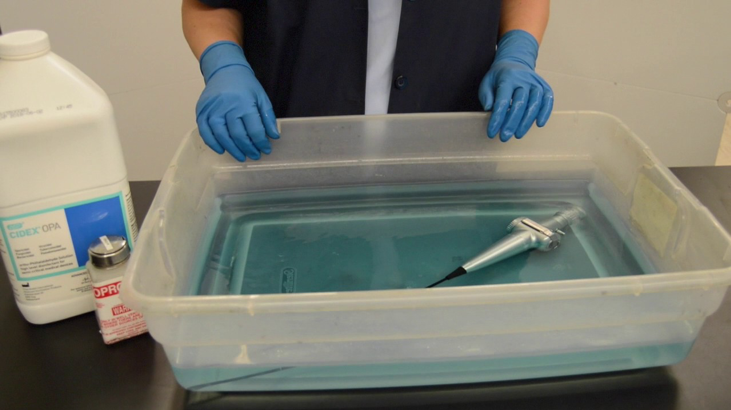What Is Glutaraldehyde and How Is It Used?
Glutaraldehyde or Cidex® OPA solutions are toxic chemicals and cold sterilants that are used to disinfect and clean heat-sensitive medical, surgical and dental equipment. These chemicals are also used as a tissue fixative in histology and pathology labs and as a hardening agent in the development of X-rays. *
What Health Issues Does Glutaraldehyde Pose?
Employees’ health and safety are at risk when using glutaraldehyde to clean scopes or other instruments. Short-term effects of exposure to glutaraldehyde in liquid or vapor form include eye, nose, throat and respiratory irritation, skin burns, coughing and wheezing, nausea, headaches, drowsiness, dizziness and nosebleeds. Long-term effects include sudden asthma attacks and difficulty breathing, wheezing, coughing and chest tightness. Prolonged exposure can result in a skin allergy, chronic eczema, severe itching and skin rashes. *
Testing and Mitigation of Exposure Levels
Evergreen Medical technicians have performed many tests of airborne glutaraldehyde levels because glutaraldehyde exposure monitoring is important to health care employees and their employers. Testing areas where this chemical is used is conducted with an end goal of ensuring that exposure levels are well below the permissible exposure limits (PEL).
After testing every applicable room in your facility, we compare the results to industry PELs. In addition to examining the ventilation, we also check for proper workplace practices that can further reduce the risk of exposure to glutaraldehyde.
How Can You Lower Excessive Exposure Levels?
If your levels of glutaraldehyde exceed PELs, actions to increase glutaraldehyde safety include:*
- Use engineering controls, work practices and personal protective equipment.
- Ensure that rooms are well-ventilated and have a sufficient air exchange rate.
- Use the minimum amount of glutaraldehyde necessary to disinfect equipment.
- Store this chemical in closed containers in well-ventilated areas.
- Use disinfecting soaking stations that offer an enclosed area for sterilization and a way to remove fumes.
- Purchase gloves that are impervious to this chemical, lab clothing made of polypropylene, and splash-proof goggles and/or full-face shields — and make sure employees use them.
- Prohibit eating in areas in which glutaraldehyde is used.
- Clean up spills immediately.
- Provide eye wash fountains.
* SOURCE: https://www.osha.gov/SLTC/etools/hospital/hazards/glutaraldehyde/glut.html
As with our glutaraldehyde chemical monitoring, we bring the same level of expertise to other types of chemical monitoring services. Click here to learn more about our full capabilities.

